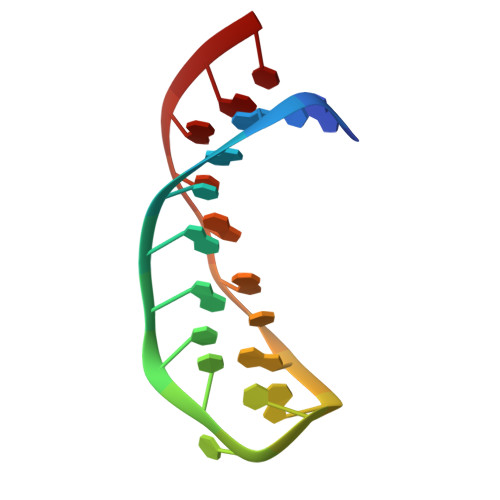CAG RNAs induce DNA damage and apoptosis by silencing NUDT16 expression in polyglutamine degeneration.
Peng, S., Guo, P., Lin, X., An, Y., Sze, K.H., Lau, M.H.Y., Chen, Z.S., Wang, Q., Li, W., Sun, J.K., Ma, S.Y., Chan, T.F., Lau, K.F., Ngo, J.C.K., Kwan, K.M., Wong, C.H., Lam, S.L., Zimmerman, S.C., Tuccinardi, T., Zuo, Z., Au-Yeung, H.Y., Chow, H.M., Chan, H.Y.E.(2021) Proc Natl Acad Sci U S A 118
- PubMed: 33947817
- DOI: https://doi.org/10.1073/pnas.2022940118
- Primary Citation of Related Structures:
7D12 - PubMed Abstract:
DNA damage plays a central role in the cellular pathogenesis of polyglutamine (polyQ) diseases, including Huntington's disease (HD). In this study, we showed that the expression of untranslatable expanded CAG RNA per se induced the cellular DNA damage response pathway. By means of RNA sequencing (RNA-seq), we found that expression of the Nudix hydrolase 16 ( NUDT16 ) gene was down-regulated in mutant CAG RNA-expressing cells. The loss of NUDT16 function results in a misincorporation of damaging nucleotides into DNAs and leads to DNA damage. We showed that small CAG (sCAG) RNAs, species generated from expanded CAG transcripts, hybridize with CUG-containing NUDT16 mRNA and form a CAG-CUG RNA heteroduplex, resulting in gene silencing of NUDT16 and leading to the DNA damage and cellular apoptosis. These results were further validated using expanded CAG RNA-expressing mouse primary neurons and in vivo R6/2 HD transgenic mice. Moreover, we identified a bisamidinium compound, DB213, that interacts specifically with the major groove of the CAG RNA homoduplex and disfavors the CAG-CUG heteroduplex formation. This action subsequently mitigated RNA-induced silencing complex (RISC)-dependent NUDT16 silencing in both in vitro cell and in vivo mouse disease models. After DB213 treatment, DNA damage, apoptosis, and locomotor defects were rescued in HD mice. This work establishes NUDT16 deficiency by CAG repeat RNAs as a pathogenic mechanism of polyQ diseases and as a potential therapeutic direction for HD and other polyQ diseases.
Organizational Affiliation:
Laboratory of Drosophila Research, The Chinese University of Hong Kong, Hong Kong, China.
















